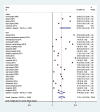Epidemiology of genital infections caused by Mycoplasma hominis, M. genitalium and Ureaplasma urealyticum in Iran; a systematic review and meta-analysis study (2000-2019)
- PMID: 32600306
- PMCID: PMC7322857
- DOI: 10.1186/s12889-020-08962-5
Epidemiology of genital infections caused by Mycoplasma hominis, M. genitalium and Ureaplasma urealyticum in Iran; a systematic review and meta-analysis study (2000-2019)
Abstract
Background: Although many species of mycoplasmas regard as normal flora, but some species causes serious genital disease. In Iran several epidemiological studies have documented the prevalence of Mycoplasma hominis, M. genitalium and Ureaplasma urealyticum in genital disorders. This meta-analysis is going to represent the prevalence of M. hominis, M. genitalium and U. urealyticum among Iranian couples and the correlation between mycoplasmas infection and infertility.
Methods: We search online databases from January 2000 to June 2019. We used following MeSH keywords (Prevalence, M. hominis, M. genitalium, U. urealyticum, male, female, fertility, Infertility, genitourinary tract infection and Iran) with all possible combinations with "OR" and "AND". Finally, forty-four articles from 2670 were chosen for data extraction and analysis by software using STATA version 14.0.
Results: This meta-analysis revealed that the prevalence of U. urealyticum was 17.53% in Iran and the prevalence of M. genitalium and M. hominis were 11.33 and 9.68% respectively. The rate of M. genitalium, M. hominis and U. urealyticum infection in women with symptoms of genitourinary tract infection was higher than men with genitourinary tract infection (6.46% vs 5.4, 7.67% vs 5.88 and 21.04% vs 12.13%, respectively). As expected, the prevalence of M. genitalium, U. urealyticum and M. hominis among infertile women (12.73, 19.58 and 10.81%) were higher than fertile women (3%, 10. 85% and 4. 35%). Similarly, the prevalence of M. hominis and U. urealyticum among infertile men (14 and 21.18%) were higher than fertile men (4 and 3%). Based on this analysis, the rate of U. urealyticum was higher than M. genitalium and M. hominis among infertile men and women compared to the fertile group. The prevalence rate of M. genitalium, M. hominis and U. urealyticum in central provinces is higher than other parts of Iran.
Conclusions: This meta-analysis reemphasizes a significant relationship between the infertility rate and U. urealyticum, M. genitalium and M. hominis infections. Our finding help to plan the prevalence map of M. hominis, M. genitalium and U. urealyticum in Iran but further studies are needed to suggest routine screening of the pathogens.
Keywords: Infertility; Iran; M. Genitalium; Mycoplasma hominis; Ureaplasma urealyticum.
Conflict of interest statement
No conflicts of interest are declared.
Figures




Similar articles
-
Ureaplasma urealyticum, Ureaplasma parvum, Mycoplasma hominis and Mycoplasma genitalium infections and semen quality of infertile men.BMC Infect Dis. 2007 Nov 8;7:129. doi: 10.1186/1471-2334-7-129. BMC Infect Dis. 2007. PMID: 17988404 Free PMC article.
-
Prevalence of cervical colonization by Ureaplasma parvum, Ureaplasma urealyticum, Mycoplasma hominis and Mycoplasma genitalium in childbearing age women by a commercially available multiplex real-time PCR: An Italian observational multicentre study.J Microbiol Immunol Infect. 2018 Apr;51(2):220-225. doi: 10.1016/j.jmii.2017.05.004. Epub 2017 Jun 28. J Microbiol Immunol Infect. 2018. PMID: 28711440
-
Prevalence of Chlamydia trachomatis, Mycoplasma hominis, Mycoplasma genitalium, and Ureaplasma urealyticum infections and seminal quality in infertile and fertile men in Kuwait.J Androl. 2012 Nov-Dec;33(6):1323-9. doi: 10.2164/jandrol.111.013821. Epub 2011 Nov 3. J Androl. 2012. PMID: 22052774
-
Mycoplasma and ureaplasma infection and male infertility: a systematic review and meta-analysis.Andrology. 2015 Sep;3(5):809-16. doi: 10.1111/andr.12078. Andrology. 2015. PMID: 26311339
-
The Associations of Genital Mycoplasmas with Female Infertility and Adverse Pregnancy Outcomes: a Systematic Review and Meta-analysis.Reprod Sci. 2021 Nov;28(11):3013-3031. doi: 10.1007/s43032-020-00399-w. Epub 2021 Jan 4. Reprod Sci. 2021. PMID: 33398853
Cited by
-
The Role of Genital Mycoplasmas in Preterm Labor.J Reprod Infertil. 2022 Apr-Jun;23(2):114-119. doi: 10.18502/jri.v23i2.8996. J Reprod Infertil. 2022. PMID: 36043133 Free PMC article.
-
Emerging antimicrobial resistance and high prevalence of genital Mycoplasma hominis and Ureaplasma urealyticum infections among infertile women in Algeria : Implications for reproductive health.Wien Klin Wochenschr. 2025 Jul 23. doi: 10.1007/s00508-025-02569-9. Online ahead of print. Wien Klin Wochenschr. 2025. PMID: 40699317
-
Clinical and uterine cervix characteristics of women with Mycoplasma and Ureaplasma in genital discharge.Rev Assoc Med Bras (1992). 2024 Jul 19;70(6):e20240045. doi: 10.1590/1806-9282.20240045. eCollection 2024. Rev Assoc Med Bras (1992). 2024. PMID: 39045962 Free PMC article.
-
Prevalence of Chlamydia trachomatis, Ureaplasma urealyticum, and Neisseria gonorrhoeae in Asymptomatic Women from Urban-Peripheral and Rural Populations of Cuenca, Ecuador.Infect Dis Rep. 2022 Aug 29;14(5):646-654. doi: 10.3390/idr14050070. Infect Dis Rep. 2022. PMID: 36136820 Free PMC article.
-
Normospermic Patients Infected With Ureaplasma parvum: Role of Dysregulated miR-122-5p, miR-34c-5, and miR-141-3p.Pathog Immun. 2024 Jan 5;8(2):16-36. doi: 10.20411/pai.v8i2.603. eCollection 2023. Pathog Immun. 2024. PMID: 38223489 Free PMC article.
References
-
- Bébéar CM, Pereyre S. Infections à « Mycoplasma hominis ». EMC - Mal Infect. 2004;1(1):1–6.
-
- Wolf M, Müller T, Dandekar T, Pollack JD. Phylogeny of Firmicutes with special reference to Mycoplasma (Mollicutes) as inferred from phosphoglycerate kinase amino acid sequence data. Int J Syst Evol Microbiol. 2004;54(3):871–875. - PubMed
-
- Lokken E. Recent bacterial vaginosis is associated with the acquisition of Mycoplasma genitalium: University of Washington; ProQuest. 2015.
Publication types
MeSH terms
LinkOut - more resources
Full Text Sources
Research Materials

